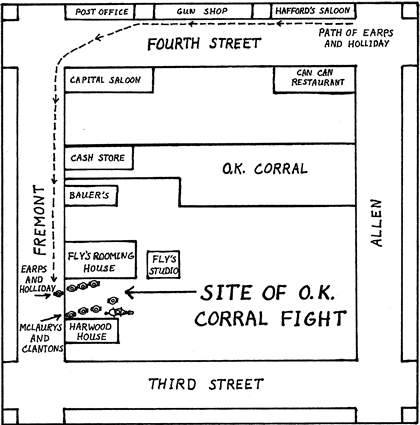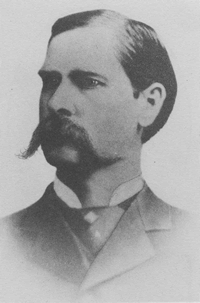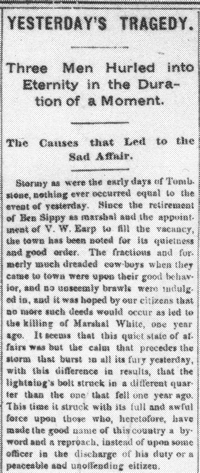
The Big Shootout
Tombstone, Arizona, October 26, 1881. The Earp brothers – Virgil, Wyatt, and Morgan – with Doc Holliday, met their foes, the Clanton and McLaury* boys, in an abandoned lot near the O. K. Corral. City Marshal Virgil Earp demanded that the cowboys disarm. They didn’t. In about forty seconds, thirty shots were fired, and the two McLaurys and Billy Clanton were dead.
Days later, Wyatt Earp and Doc Holliday were charged with murder.
Your job: Are they guilty?
The Gunfight at the O. K. Corral is probably the most famous gun battle of the Wild West. It has been recounted in numerous movies, TV programs, and novels, most of which portray the Earp boys as tough, handsome lawmen upholding the peace. Was this true?
In this article, you will see evidence on both sides of the shootout. Your mission (should you choose to accept it) is to use critical thinking skills to decide whether the killings of the McLaurys and Billy Clanton were justifiable acts of self-defense, or murder.
First, here are two criteria to help you judge the evidence.

1. Is it a primary or secondary source?
If you wanted to know if George Washington cut down a cherry tree and I told you that I’d seen him do it, historians would call me a primary source – a first-hand witness. However, if I told you that I’d heard from a friend of mine that George Washington cut down that cherry tree – my friend said he saw him do it – then I’d be a secondary source. I didn’t see George do it; I only heard about it from someone else.
Historians believe a primary source is more reliable than a secondary source because a story can change as it is told from one person to the next. When you decide how reliable a piece of evidence is in The Gunfight at the O. K. Corral, consider whether it is a primary or a secondary source.
2. Does the source have a reason to lie?
But what if I’m lying when I say I saw George Washington cut down a cherry tree? How can you tell?
Well, you can’t tell if I am lying, but sometimes you can tell if someone has a reason to lie. We aren’t asking if someone really is lying. We’re just trying to see if a person may have had a reason to lie. Someone has a reason to lie if he would benefit by changing or distorting what he saw. Here are a couple of questions to ask:
- Do they say things that make them look good? Maybe it makes them look brave, humble, or smart.
- Do they say things that help their interests? Maybe it promotes their business or keeps them out of trouble.
If we know someone does not have a reason to lie, we should prefer his evidence more. If we know someone has a reason to lie, we should closely examine his story and look for other evidence that agrees with what he says.
Meanwhile, back at the O. K. Corral. . .
Wyatt Earp had this to say about the shootout:

[Frank and Tom McLowery, Billy Clanton and] Ike Clanton stationed themselves on a fifteen foot lot between two buildings across the street and sent us word that if we did not come down there and fight they would waylay and kill us. So we started down after them – Doc Holliday, Virgil, Morgan, and I. As we came to the lot, they moved back and backed against one of the buildings.
“I’m going to arrest you boys,” said Virgil.
For answer, their six-shooters began to spit. Frank McLowery fired at me and Billy Clanton at Morgan. Both missed. I had a gun in my overcoat pocket, and I jerked it out at Frank McLowery, hitting him in the stomach.” (Wyatt Earp in the San Francisco Examiner, August 2, 1896) (The Earps Talk edited by Turner E. Alford)
Wyatt’s statement said three things:
- The Clanton Bunch threatened to kill one or more of the Earp brothers.
- Before the fight started, Virgil Earp tried to arrest them peacefully.
- The Clanton Bunch fired first; and the Earps, with Doc Holliday, fired in self-defense.
Why should we consider Wyatt a reliable source on the gunfight?
For one, Wyatt offers a firsthand account of what happened. He was there, with a front- row seat, and can tell us what he saw. Wyatt is a primary source. Other primary sources would be the other Earp brothers, Doc Holliday, Ike Clanton, the horse (whose name I don’t know), and any bystander.
However, there is one weak point to Wyatt’s story: he was on trial for murder. Wyatt had a good reason to say that he and his brothers shot in self-defense. Wyatt had a reason to lie: he didn’t want to hang. But does this mean Wyatt was lying? While we can’t know for sure, we can say he had a good reason to lie. How would you rate Wyatt’s account? Is he reliable?
Let’s look at another account. This is from John P. Gray, a bystander who saw the shootout.
The three Earps – Wyatt, Virgil, and Morgan – and Doc Holliday had stepped suddenly out on to Fremont Street from the rear entrance of the O. K. stable lot and immediately commenced firing on the cowboys who were preparing to leave town. . . . It was over almost as soon as begun. A play enacted by the Earps to wipe out those cowboys on the pretense of enforcing the law – and carried out under the manner of shooting first and reading the warrant to the dead men afterward. But in this case, I doubt if there was ever a warrant issued. The Earps called out, “Hands up” and began firing almost simultaneously. (Tombstone: Myth and Reality by Odie B. Faulk)
Mr. Gray’s story is different from Wyatt’s.
- Mr. Gray apparently had no knowledge of any threat to kill the Earps.
- The Earps gave the cowboys virtually no warning before firing.
- The Earps fired first, gunning down unprepared cowboys.
So, how reliable is Mr. Gray? Mr. Gray has no reason to lie – that we know of – and Mr. Gray is a primary source. Can you think of any weaknesses in Mr. Gray’s story?
Now we have two stories that disagree about what happened. The important points in both stories are whether (1) the Clanton boys threatened the Earps beforehand; (2) the Earps gave sufficient warning; and (3) who fired first.
The next step is to look at more evidence from as many different sides as possible.
Now, you might ask: “Why does it matter what happened at the O.K. Corral?” What we are trying to teach here is that studying history isn’t all straightforward fact. Studying history often involves studying controversies and unsolved mysteries: what happened to the French Dauphine? Were the conquistadors honorable men or bloody conquerors? Who killed JFK? What we need are some tools, like the ones we are giving here, to evaluate and choose between the opposing viewpoints.

Evaluate more evidence
For each of the pieces of evidence below, decide (1) which side the evidence supports (Earp’s or Clanton’s) in the three important points above, and (2) how reliable the evidence is: very reliable, moderately reliable, or unreliable.
1. I think it was Holliday who fired first. Their backs were to me. I was behind them. The smoke came from him. I could not tell who fired the second shot. (William Allen, bystander)
2. Town Marshal, Virgil Earp, in his testimony during the trial, told of an incident which happened earlier in the day: “I found Ike Clanton on Fourth Street between Fremont and Allen with a Winchester rifle in his hand and a six-shooter stuck down his breeches. I walked up and grabbed the rifle in my left hand. He let loose and started to draw his six-shooter. I hit him over the head with mine and knocked him to his knees and took his six-shooter from him. I asked him if he was hunting for me. He said he was, and if he had seen me a second sooner he would have killed me. I arrested Ike for carrying firearms . . . inside the city limits.” [Public court documents recorded that day that Ike Clanton was arrested and fined $25 for carrying a concealed firearm.]
3. [Earlier] when Holliday and the Earps appeared on the streets, he [Ike Clanton] repeatedly cried, “the ball will open.” He had also paid an early morning visit to Fly’s Rooming house hunting Doc Holliday with a rifle and a six-shooter. (Kate Elder, citizen and friend of Doc Holliday)
4. Mrs. King saw the Earp party as they approached the vacant lot. This is what she said: “I saw four men coming down the sidewalk. I only knew one of the party and that was Mr. Holliday. And there were three other gentlemen, who someone told me were the Earps. Mr. Holliday was next to the buildings, on the inside. He had a gun under his coat. . . I stood in the door until these gentlemen passed and until they got to the second door. . . I heard this man on the outside – he looked at Holliday and I heard him say, ‘Let them have it!’ And Doc Holliday said, ‘All right.’” (Quotes 1-4. The Earps Talk edited by Turner E. Alford)
Your turn
Write a short paragraph describing what you think happened during the Gunfight at the O.K. Corral. Give evidence to support your opinion.
References
Die in the West, The Story of the O.K. Corral Gunfight by Paula Mitchell Marks (William Morrow and Co., Inc., 1989).
The Earps Talk edited by Turner E. Alford (Creative Pub. Co., 1982).
The Gunfighters by Paul Trachtman (Time-Life Books, 1974).
Inventing Wyatt Earp, His Life and Many Legends by Allen Barra (Carroll & Graf Publishers, Inc., 1998).
Tombstone: Myth and Reality by Odie B. Faulk (Oxford University Press, 1972)
*McLaury (McLowery) is spelled different ways in different sources with McLaury being the most common.
First appeared in Homeschooling Today magazine, March-April 2004.
Copyright March 01, 2004, all rights reserved. 14325 views
Facebook Comments
Site Comments
1 • Herman King • May 06, 2009 • 10:06 PM
I think it was a case of cold-blooded murder.Wyatt Earp proved himself corrupt after being run out of Tombstone.